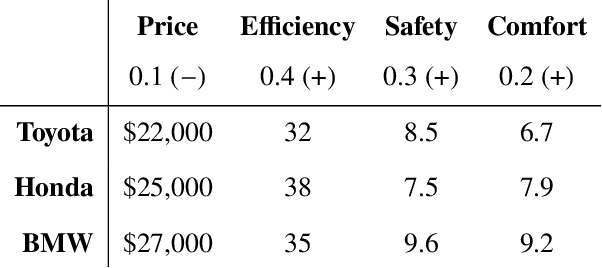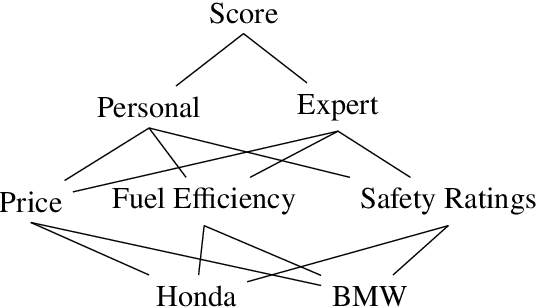Martin Erwig
Explaining Results of Multi-Criteria Decision Making
Sep 10, 2022



Abstract:We introduce a method for explaining the results of various linear and hierarchical multi-criteria decision-making (MCDM) techniques such as WSM and AHP. The two key ideas are (A) to maintain a fine-grained representation of the values manipulated by these techniques and (B) to derive explanations from these representations through merging, filtering, and aggregating operations. An explanation in our model presents a high-level comparison of two alternatives in an MCDM problem, presumably an optimal and a non-optimal one, illuminating why one alternative was preferred over the other one. We show the usefulness of our techniques by generating explanations for two well-known examples from the MCDM literature. Finally, we show their efficacy by performing computational experiments.
Intersectionality Goes Analytical: Taming Combinatorial Explosion Through Type Abstraction
Jan 25, 2022Abstract:HCI researchers' and practitioners' awareness of intersectionality has been expanding, producing knowledge, recommendations, and prototypes for supporting intersectional populations. However, doing intersectional HCI work is uniquely expensive: it leads to a combinatorial explosion of empirical work (expense 1), and little of the work on one intersectional population can be leveraged to serve another (expense 2). In this paper, we explain how representations employed by certain analytical design methods correspond to type abstractions, and use that correspondence to identify a (de)compositional model in which a population's diverse identity properties can be joined and split. We formally prove the model's correctness, and show how it enables HCI designers to harness existing analytical HCI methods for use on new intersectional populations of interest. We illustrate through four design use-cases, how the model can reduce the amount of expense 1 and enable designers to leverage prior work to new intersectional populations, addressing expense 2.
 Add to Chrome
Add to Chrome Add to Firefox
Add to Firefox Add to Edge
Add to Edge